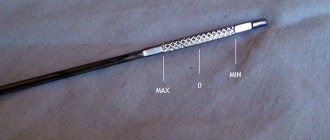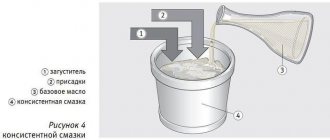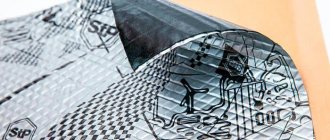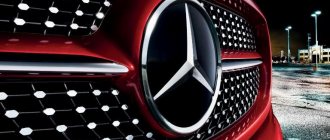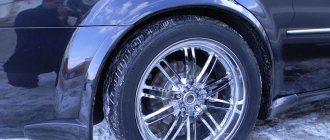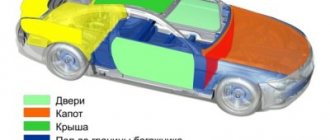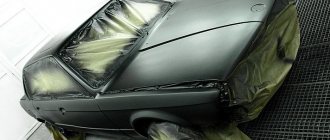Engine ZMZ-406
ZMZ-406 is a line of in-line 4-cylinder 16-valve gasoline automobile internal combustion engines produced by Zavolzhsky Motor Plant OJSC. The ZMZ-406 engine was originally designed for installation on the promising GAZ-3105 model. The first engine prototypes appeared in 1993, small-scale assembly began in 1996, and entered the main assembly line in 1997.
The engine was originally designed for modern microprocessor-controlled power and ignition systems; carburetor versions appeared later (injection version - ZMZ-4062.10, carburetor versions - ZMZ-4061.10 and 4063.10). For the first time in the Russian engine industry, the following were used in the design of the ZMZ-406: 4 valves per cylinder, hydraulic pushers, a 2-stage chain drive of 2 camshafts, an electronic fuel injection and ignition control system.
| Production | |
| Engine make | ZMZ-406 |
| Years of manufacture | 1997-2008 |
| Cylinder block material | cast iron |
| Supply system | injector/carburetor |
| Type | in-line |
| Number of cylinders | 4 |
| Valves per cylinder | 4 |
| Piston stroke, mm | 86 |
| Cylinder diameter, mm | 92 |
| Compression ratio | 9.3 8* |
| Engine capacity, cc | 2286 |
| Engine power, hp/rpm | 100/4500* 110/4500** 145/5200 |
| Torque, Nm/rpm | 177/3500* 186/3500** 201/4000 |
| Fuel | 92 76* |
| Environmental standards | Euro 3 |
| Engine weight, kg | 185* 185** 187 |
| Fuel consumption, l/100 km - city - highway - mixed. | 13.5 — — |
| Oil consumption, g/1000 km | up to 100 |
| Engine oil | 5W-30 / 5W-40 / 10W-30 / 10W-40 / 15W-40 / 20W-40 |
| How much oil is in the engine | 6 |
| When replacing, pour, l | 5.4 |
| Oil change carried out, km | 7000 |
| Engine operating temperature, degrees. | ~90 |
| Engine life, thousand km - according to the plant - in practice | 150 200+ |
* - for engine ZMZ 4061.10 ** - for engine ZMZ 4063.10
Design Features
Officially, the ZMZ 406 engine became the third after 24D and 402 in the line of power drives of the Zavolzhsky plant. Received microprocessor ignition, DOCH gas distribution circuit with a two-stage chain drive.
The developers still used an in-line engine design with 4 cylinders, but there were two camshafts, they are located on top, inside the cylinder head. The compression ratio of the internal combustion engine was increased by the plant designers to 9.3 in the basic version 4062.10 due to the central location of the spark plug inside the combustion chamber.
Gas distribution mechanism design
Reliability is increased due to a cast-iron cylinder block without liners, a reduction in the piston stroke to 86 mm and the weight of the entire ShPG group. The connecting rods, bolts, crankshaft and piston rings are made from high-strength materials, so major overhauls are required less frequently.
Timing chain tensioner
The chain tensioners are automatic, double-acting - preloaded by a spring during hydraulic operation. The degree of oil purification is increased by installing a full-flow disposable filter. A separate V-belt drive is provided for attachments. The ECU firmware corresponds to SOATE, ITELMA VS5.6, MIKAS 5.4 or 7.1 versions
Advantages and disadvantages of the engine
Before we talk about changing the oil in a Gazelle engine, it’s worth finding out how good or bad this engine is. This way you will better understand in which modification it is better to purchase a car.
The strengths of the 405 family include:
- the presence of a modified cylinder head using a two-layer metal gasket, supplemented with spring components;
- the total weight of the cylinder block has decreased by 1.35 kilograms compared to its predecessor;
- A catalytic three-component type of converter is used, which allows it to comply with Euro 3 requirements;
- due to modifications, highway consumption decreased to 8.8 liters per 100 kilometers;
- An oil purification system is used.
Some consider the fact of using a microprocessor to control the ignition timing an advantage, while others call it a disadvantage. The system works better and more efficiently, but it is impossible to repair this unit in highway conditions when the car is stuck.
At the same time, hydraulic compensation of the thermal gap in the valves led to a reduction in the cost of maintaining the Gazelle. So, you no longer need to visit a car service center to adjust the valves, as happened before.
This is frankly a good engine that is perfect for the Gazelle car. From its technical characteristics we highlight the following:
- compression ratio is 9.4;
- working volume 2.4 liters;
- torque reaches 211 Nm;
- the engine produces 152 horsepower.
With such an engine, Gazelle feels confident in the city and on the highway. If you use suitable and compliant motor oils, you will be able to minimize engine contamination, reduce friction between contacting surfaces and extend the life of the power unit.
When to change the oil in a GAZelle box and which gearbox oil to choose
So, as you know, the Gazelle has a seriously modified manual transmission from a Volga car. Considering that the Gazelle is a truck, while the Volga is a passenger car, without proper care, the gearbox on a Gazelle under load will quickly fail. Usually by 80 thousand km a gearbox hum appears, gears fall out, etc.
- Having decided on the intervals, now let's look at which oil to choose for the GAZelle box. At the factory, a cheap version of TAD17 is poured into the gearbox. Such a lubricant can only be considered a break-in lubricant, that is, it is better to change it after 500-1 thousand km.
The manufacturer indicates that GL-4 oil with a viscosity of 75W-90 should be poured into this gearbox. You can also fill in GL-5 with this viscosity, but in this case problems with synchronizers may arise.
In practice, you should abandon the use of cheap mineral oils in favor of semi-synthetics or synthetics. First of all, mineral water gets stuck in winter, gears are difficult to engage before warming up, wear increases, and fuel consumption increases. It is optimal to choose high-quality semi-synthetics.
- To understand how much oil is in a GAZelle box and how much it needs to be filled, it is not enough just to study the manual. The manual says 2 liters. However, in practice one should not exclude casting defects, different versions of the gearbox, etc.
It turns out that the volume of oil in a particular box can be either 1.2 or up to 1.5 liters. This means that for replacement you should immediately purchase 2 liters, since underfilling is a serious problem and will quickly damage the gearbox. Oil must be filled strictly according to the level of the oil filler plug.
How much oil to fill in a Cummins engine
First generation from 2010
The Gazelle with a Cummins engine is equipped with a reinforced manual transmission with different gear ratios. Also installed are drive axles modified for low-speed diesel engines. In addition, diesel Gazelles have changed exhaust systems (a different manifold and bellows compensator are installed) and steering with a ZF power steering pump. One of the latest modifications of the Cummins ISF 2.8 diesel engine for the Gazelle Business family car is its version S4129T with the Euro-4 environmental class, which is achieved due to the presence of a catalytic converter. The first versions of Cummins diesel engines met Euro-3 standards - for example, this is the S3129T modification, valid until 2012. The modern Cummins line is quite economical, given the average fuel consumption of 8.5-10.3 liters per 100 km, which is half as much as gasoline internal combustion engines. According to the manufacturer, the resource of the Cummins ISF 2.8 diesel engine can exceed 1 million kilometers.
Also read: Motor oil for the VAZ-2105 engine
Diesel engines since 2010
Cummins IS2.8S4129P 2.8 120 l. pp., oil volume – 6.5 liters, tolerance and viscosity: API-CF, CG-4, CH-4, CI-4; ACEA A3/B4/E7; SAE 10W-40, 5W-40, 5W-30, 0W-40
How the box works
GAZelles are equipped with 4- or 5-speed manual transmissions. Components of the device:
- 2 aluminum crankcases connected by 100 bolts;
- speedometer drive gear;
- primary and secondary shafts connected to the cardan and crankshaft;
- an intermediate shaft on which the cut reverse and 1st stage teeth are located;
- pressed gear block;
- inertial synchronizers;
- reverse gear is provided by a gear block;
- clutch for engaging 3rd and 4th gears;
- system for blocking simultaneous launch of several speeds;
- spring-loaded balls for fastening different levels of the box;
- mechanism of the damper device of the lever and control elements.
The design of the unit allows for timely diagnosis of the first signs of malfunction to prevent more dangerous failures.
Specifications
Key characteristics of the gearbox of GAZelle cars:
- 4- or 5-speed transmission;
- 5 speeds - 1 reverse and 4 forward.
For the transmission, the following parameters can be noted:
- three-way lever located in the assembly;
- the mass of the part is 56 kg;
- oil tank capacity - 3 l;
- gear ratios for five stages - 6.55; 3.09; 1.71; 1; 7.77.
- The fourth stage in the gearbox is direct.
List of car models in which it was installed
Since the ZMZ 406 engine has three versions, each of them was used on specific models of the car manufacturer GAZ:
- ZMZ 4062.10 – GAZ 31054 Luxury configuration; GAZ 3102 (1996 – 2008);
- ZMZ 4061.10 – GAZ 3302, 33023, 2705, 3221;
- ZMZ 4063.10 – GAZ 3302, 33023, 2705, 3221, 32213, 322132, 32214, SemAR 3234, Ruta, Bogdan and Dolphin.
GAZ Gazelle Farmer
In the first case, the engine characteristics were suitable for the urban cycle of executive cars of officials and governments. Carburetor modifications reduced the operating budget of Gazelle vans, utility vehicles and trucks.
Malfunctions and repairs of the Volga / Gazelle ZMZ-405 engine
The ZMZ-405 engine was developed on the basis of the 406 engine and differs in piston diameter (increased from 92 to 95.5 mm), the height of the cylinder block is the same, the inter-cylinder jumpers have become thinner, slots for cooling have appeared (there are none on the block of Euro-3 engines), the connecting rods remained the same. Otherwise, the engine remained the same, due to the increased volume, the power increased by 7 hp, the torque increased, the latest engines began to comply with Euro-3 environmental standards and nothing more, still the same ZMZ406. Another large-volume engine was created on the same block - ZMZ-409.
Modifications of the ZMZ 405 engine
1. ZMZ 4052.10 - main motor. Used on Volga and Gazelle cars. 2. ZMZ 40522.10 - analogue to 4052.10, complies with Euro-2 environmental standards. Used on Gazelle and Volga cars. 3. ZMZ 40524.10 - analogue to 40522.10, complies with Euro-3 environmental standards. Used on Volga passenger cars. 4. ZMZ 40525.10 - analogue to 40522.10, complies with Euro-3 environmental standards. Used on Gazelle trucks. 5. ZMZ 4054.10 - turbo version 405, steel crankshaft, forged piston, intercooler, SZh 7.4, power 195 hp/4500 rpm, torque 343 Nm/rpm. It was produced in small batches and was prohibitively expensive, so tuners preferred to install proven Toyota 1JZ/2JZ.
Malfunctions of ZMZ 405 engines
The malfunctions of the 405th Volga engine absolutely repeat the problems of the ZMZ-406, all the same problems with the oil under the valve cover, because their differences are minimal. We read about the pros and cons of ZMZ-406.
What oil to pour into a GAZelle with a 406 engine
The oil for the ZMZ 406 engine must comply with the classification STO AAI 003-98 (API): B4/D2 (SJ/CF); B4/D2 (SG/CD); SJ/SH/CF. And also correspond in viscosity to the values of maximum and minimum annual temperatures:
- from -25 to +20 °C 5W-30;
- from -25 to +35 °C 5W-40;
- from -20 to +30 °C 10W-40;
- from -20 to +35 °C 15W-30;
- from -15 to +35 °C 15W-40;
- from -15 to +45 °C 15W-40;
- from -10 to +45 °C 20W-40;
- from -5 to +45 °С SAE 30.
The manufacturer offers the following brands of oil, both domestic and foreign, for use: “Slavneft Lux” 5W-30, 5W-40, 10W-30, 10W-40, 15W-40, 20W-50; "Slavneft Ultra" 5W-30, 5W-40, 10W-30, 10W-40, 15W-40, 20W-50; "Lukoil Super" 5W-30, 10W-40, 15W-40; "Esso Ultra" 10W-40, "Esso Uniflo" 15W-40.
Maintenance schedule ZMZ 406 2.3 l/100 l. With.
According to the manufacturer's requirements, the ZMZ 406 engine is serviced in the following order:
- inspection of the timing chain after 30,000 miles, replacement after 100,000 km;
- oil and filter change after 10,000 km;
- replacing the coolant approximately every two years or 30,000 mileage;
- recharging the battery every autumn, replacing after 50,000 km;
- spark plugs last for 60,000 miles;
- the fuel filter becomes unusable after 30,000 km, the air filter - 20,000 km;
- Ignition coils fail after 50,000 miles.
Repair of ZMZ 406
The manufacturer recommends using high-quality lubricant for engines so that the hydraulic compensators and oil pump work properly. Initially, the cooling system has weak points - the radiator and thermostat. All attachments are highly durable, with the exception of the pump, the polymer rotor of which lasts about 30,000 km. Due to the heavy weight of the engine, it is very difficult to carry out major repairs yourself in a garage without a hoist.
GAZ 2705 | Adjustment data, filling containers and fluids
1.8. Adjustment data, filling containers and fluids
GENERAL INFORMATION
Valve clearances (mm)
| For engines model 2E* | |
| – intake valves | 0,20 |
| – exhaust valves | 0,20 |
| For engines model 4E-FE** | |
| – intake valves | 0,15 – 0,25 |
| – exhaust valves | 0,31 – 0,41 |
| For engines models 4A-FE and 7A-FE** | |
| – intake valves | 0,15 – 0,25 |
| – exhaust valves | 0,25 – 0,35 |
| For diesel** | |
| – intake valves | 0,25 |
| – exhaust valves | 0,30 |
* on a hot engine ** on a cold engine
Candles
| For engines model 2E |
| For engines model 4E-FE |
| For engines models 4A-FE and 7A-FE |
Gap between spark plug electrodes (mm)
| Model 2E engine | 1,1 |
| Engine 4E-FE, 4A-FE and 7A-FE | 0,8 |
Belt deflection (used) at a force of 10 kgf
For engines model 2E and 4E-FE
| A. Alternator B. Crankshaft C. Air conditioning drive D. Power steering pump E. Coolant pump A. Alternator B. Crankshaft C. Air conditioning drive D. Tensioner pulley E. Coolant pump A. Alternator B. Crankshaft C. Power steering pump D. Coolant pump |
| 11,0 – 12,5 |
| 5,0 – 6,5 |
| 7,0 – 8,5 |
| 11,0 – 13,0 |
For engines models 4A-FE and 7A-FE
| A. Power steering pump B. Coolant pump C. Crankshaft D. Air conditioning drive E. Generator |
| 11,5 – 13,5 |
| 8,5 – 9,5 |
| 6,0 – 8,0 |
For diesel engine
| A. Generator B. Crankshaft C. Power steering pump A. Generator B. Crankshaft C. Power steering pump A. Generator B. Crankshaft C. Air conditioning drive |
| 12,0 – 14,0 |
| 15,0 – 17,0 |
| 15,0 – 18,0 |
Engine lubrication Oil volume, l
| For engines model 2E | |
| – with filter | 2,8 |
| - without a filter | 2,6 |
| For engines model 4E-FE | |
| – with filter | 3,0 |
| - without a filter | 2,8 |
| For engines model 7A-FE | |
| – with filter | 3,7 |
| - without a filter | 3,5 |
| For diesel | |
| – with filter | 4,3 |
| - without a filter | 3,6 |
Oil brand
For gasoline engines: multigrade oil of API grade (SG or SH), or ILSAC.
For diesel engines: oil grades no worse than API CD.
Cooling system
| Total capacity, l | |
| For 2E engines | 4,6 |
| For 4E-FE engines | |
| – with manual transmission without air conditioning | 4,9 |
| – with air conditioning | 4,6 |
| – with automatic transmission | 4,7 |
| For engines 4A-FE | |
| – with manual transmission without air conditioning | 5,4 |
| – with air conditioning | 5,0 |
| – with automatic transmission | 5,2 |
| For engines 7A-FE | 5,6 |
| For diesels | 7,0 |
Coolant type
Fluid with antifreeze (ethylene glycol based) or anti-corrosion additives (Toyota Radiator Conditioner fluid or equivalent).
Do not use alcohol-based antifreeze.
Battery
| Serviceable batteries | |
| Electrolyte density at 20° C | |
| On gasoline engines: | |
| – on a fully charged battery | 1,260 |
| – on a partially discharged battery | 1,160 |
| – on a completely discharged battery | 1,060 |
| On diesels: | |
| – on a fully charged battery | 1,280 |
| – on a partially discharged battery | 1,180 |
| – on a completely discharged battery | 1,080 |
Charge current
| Maintenance free batteries | no more than 5A |
| Batteries serviced: | |
| – accelerated charge | no more than 15A |
| – slow charge | no more than 5A |
Clutch
| Pedal free play (mm) | 5 – 15 |
| Liquid type | SAE J1703 or FMVSS N116 DOT 3 |
Manual transmission
| On gasoline engines | |
| Oil volume, l: | |
| – for engines 2E, 4E-FE and 4A-FE | 1,9 |
| – for engines 7A-FE | |
| with anti-lock system | 4,5 |
| without anti-lock braking system | 5,0 |
Oil brand
| For engines 2E, 4E-FE and 4A-FE | universal gear oil API GL-4 or GL-5 |
| For engines 7A-FE | universal gear oil API GL-5 |
| Recommended viscosity | SAE 75W-90 |
| On diesels: | |
| Oil volume, l | 2,6 |
| Oil brand | |
| – universal gear oil API GL-4 or GL-5 | |
| Recommended viscosity | SAE 75W-90 |
Automatic transmission
3-speed transmission
| Transmission fluid volume (filling rate) | up to 2.5 l |
| Liquid brand | Transmission fluid DII or DEXRON III (DEXRON II) |
Differential
| Liquid volume | 1.4 l |
| Liquid brand | Transmission fluid DII or DEXRON III (DEXRON II) |
| 4-speed transmission | |
| – volume of liquid | up to 3.1 l |
| – brand of liquid | Transmission fluid DII or DEXRON III (DEXRON II) |
Rear axle differential
| Oil volume, l | 0,9 |
| Oil brand | hypoid gear oil API GL-5 |
| Recommended viscosity | above -18°С SAE 90, below -18°С SAE 80W or 80W-90 |
Brakes
| Minimum travel of a fully depressed pedal with the engine running (at a force of 50 kgf) | |
| – with rear drum brakes | 55 mm |
| – with rear disc brakes | 60 mm |
| Free pedal travel | 1 – 6 mm |
| Number of clicks of the handbrake lever (when adjusted) at a force of 20 kgf | 4 – 7 |
| Brake fluid brand | SAE J1703 or FMVSS N116 DOT 3 |
Steering
| Steering wheel play | no more than 30 mm |
| Hydraulic fluid grade | Transmission fluid DEXRON II or DEXRON III |
Fuse box on driver's side mudguard for left-hand drive vehicles
Passenger side mudguard fuse box
Location of fuses in the engine compartment (2E engines)
Location of fuses in the engine compartment (engines 4E-FE, 4A-FE, 7A-FE and 2C) with the exception of cars from Norway, Iceland, Denmark, Sweden and Finland
Location of fuses in the engine compartment (engines 4E-FE, 4A-FE, 7A-FE and 2C) for cars from Norway, Iceland, Denmark, Sweden and Finland
Type A fuses
| 1.FOG 15A | no chain |
| 2. CIG&RADIO 20 A | cigarette lighter, digital clock display, air conditioning system, receiver, player, electric rear view mirrors, airbag |
| 3. TAIL 15 A | tail lights, parking lights, instrument lighting, interior lighting, rear fog lights, daytime running lights |
| 4. IGN 10 A | multi-channel direct fuel injection system/sequential injection system, cooling system fans, airbag |
| 5. ECU-B 10 A | rear fog lights, daytime running lights |
| 6. DEF-I/UP 7.5 A | multi-channel direct fuel injection system/sequential injection system |
| 7. STOP 15 A | brake signals, anti-lock braking system |
| 8.TURN 7.5 A | direction indicators |
| 9.TURN 10 A | turn indicators, emergency stop signals |
| 10. ECU-IG 15 A | engine starting system, anti-lock braking system |
| 11. SEAT HTR 20A | heated seats |
| 12. DEF 30 A | rear window defroster |
| 13. GAUGE 10 A | indicators and meters, warning indicator lamps (except low battery indicator and open door alarm), reverse lamps, air conditioning system, battery charging system, daytime running lights |
| 14. WIP 20 A | windshield and rear window cleaner and washer, headlight cleaner |
| 15.A/C 15A | air conditioning system |
| 16. DOME 20 A | interior lighting, cargo compartment lighting, trunk lighting, clock, door open light, radio, player, anti-lock braking system |
| 17. HAZ-HORN 20 A | emergency stop signals, horn |
| 18. FAN-I/UP 7.5 A | multi-channel direct fuel injection system/sequential injection system |
| 19. SPARE 7.5 A | spare |
| 20. SPARE 10 A | spare |
| 21. SPARE 20 A | spare |
| 22. HEAD (RH) 15 A | right headlight |
| 23. HEAD (LH) 15 A | left headlight |
| 24. DRL 7.5 A | Daytime Running Lights |
| 25. ALT-S 7.5 A | battery charging system |
| 26. EFI.-HTR 15 A | multi-channel direct fuel injection system/sequential injection system |
| 27.EFI 15A | multi-channel direct fuel injection system/sequential injection system |
| 28. HEAD (RH-UPR) 10 A | high beam right headlight |
| 29. HEAD (LH-UPR) 10 A | left high beam |
| 30. HEAD (RH-LWR) 10 A | low beam right headlight |
| 31. HEAD (LH-LWR) 10 A | low beam left headlight |
Type B fuses
| 32. POWER 30 A | electric window lift, electric door locking system, electric sunroof |
| 33. DEF 30 A | rear window defroster |
| 34. HEATER 40 A | air conditioning system |
| 35. AM2 30 A | engine starting system |
| 36. FAN 30 A | engine cooling fan |
| 37. CDS 30 A | engine cooling fan |
Type C fuses
| 38. AM1 40 A (petrol engines) | engine starting system |
| GLOW 80 A (diesel engines) | engine starting system |
| 39. ALT 80 A (2E engines) | engine starting system, tail lights, STOP fuses, ECU-B |
| AM1 100 A (2C engines) | engine starting system, rear lights, STOP fuses, ECU-B and ABS |
| ALT 100A | (engines 4E-FE, 4A-FE and 7A-FE) |
| 40. ABS 50 A | anti-lock braking system |
Choosing a lubricant
The smooth functioning of the gearbox, as well as the timing of replacement, largely depend on the quality and characteristics of the engine oil.
In the video from user Mechanic, you can learn more about choosing transmission fluid for a GAZelle car.
When choosing a lubricant for a GAZelle gearbox, you should take into account the following factors:
- Recommendations of the machine manufacturer for lubricants, which require certain requirements. It is best to use more expensive and high-quality oils, since by saving money on lubricants, you can spend a lot on repairing the unit.
- When choosing a brand of oil, it is necessary to take into account not only the operating conditions of the car (ambient temperature, road surface condition, total mileage), but also the manufacturer of the transmission fluid, as well as its reputation in the automotive market.
- You should purchase a “transmission” that is approximately 1 liter more than what is required for replacement. It will be needed later when topping up, and you only need to add the oil that was filled in earlier.
When choosing an oil, a lot depends on the climate in which the car is operated. In areas with low air temperatures, a liquid of lower viscosity is poured for the winter than in the southern regions.
Car service books do not always contain recommendations regarding lubricant. For example, the operating instructions for a car with a UMP engine do not give specific instructions on the choice of oil; only a viscosity that meets the SAE 75W standard is recommended.
The following brands of oil correspond to these indicators:
- Castrol 75W140;
- Magnum 75W80;
- Total 75W80;
- Manol 75W80.
Cummins gear oil has also proven itself to be good, and is poured even into the boxes of business-class cars.
The presence of mineral additives in lubricants that meet the SAE 75W standard improves their characteristics, including density and viscosity. Such oils harden at a temperature of about -45°C, which allows them to be used in almost all regions of the Russian Federation.
Oil pressure too high
Post by Barahlush » Wed Jul 17, 2013 13:00
Patr is three years old, I bought it a month ago, I myself changed the oil in the axles, gearbox and transfer case, and a week ago I changed the oil in the engine. At the first departure, a high pressure signal beeped in the engine lubrication system (pressure 5.0 - 5.2 atm). I changed the oil filter from Livnovsky to FRAM PH8A - nothing has changed. When I start a cold engine, at idle the pressure is 4.6 - 4.7 atm., as it warms up it drops to 4.0 atm. (at idle), if you drive, then at 2500 rpm it goes beyond 5 atm. and starts beeping. After driving 5 – 7 km. The idle pressure drops to 2.5 atm at 3000 rpm. 4.5 atm., that is, I drive normally, nothing squeaks, the oil pressure remains at the same level (idle speed - 2.5 atm., 3000 rpm - 4.5 atm.) Questions: 1. what oil pressure is considered normal, for example, at idle, at 2 and 3 thousand rpm? 2. what could be the reason?
PS Before changing the oil, there were no signals about excess pressure, so I did not observe the dynamics of pressure depending on the speed.
Post 191 » Wed Jul 17, 2013 13:21
Post by Barahlush » Wed Jul 17, 2013 22:08
Post by ZamPoteh » Wed Jul 17, 2013 22:26
Post by mudman » Wed Jul 17, 2013 22:32
Shit this is not normal! There was such crap until 6.0. The hose may become delaminate or the lines may be clogged.
For me personally, the reason was as follows: The line and valve were clogged. I unscrewed the oil filter, removed the pressure reducing valve and pulled out a piece of paranit from there, also (from the line where the filter was screwed in) I pulled out two more small pieces with a wire, then started the engine a little, so that the remaining oil and oil were squeezed out. After putting everything back in place, the pressure was normal. Before that, I shook everything up, even replaced the pump. 5.7-6.0 and that's it.
Post by Barahlush » Wed Jul 17, 2013 23:11
Post by Barahlush » Wed Jul 17, 2013 23:32
Post 191 » Thu Jul 18, 2013 06:14
Post by mudman » Thu Jul 18, 2013 13:22
Post by Barahlush » Thu Jul 18, 2013 16:32
Thanks everyone for the helpful tips!
After scouring the forums, I concluded that the likelihood of sensor glitches is much higher than the likelihood of clogging, so I want to start by measuring the oil pressure with a pressure gauge. But questions arise: 1. Which pressure gauge should I use? (I have a pressure gauge for measuring tire pressure and a compression gauge - is at least one of them suitable for this purpose?) 2. Where should I screw (insert) the pressure gauge, what kind of thread is there?
Post by mudman » Fri Jul 19, 2013 13:57
It was necessary to measure it with a pressure gauge from the very beginning, since the keg is such an unreliable thing.
You unscrew the DDM (barrel) and screw in the pressure gauge, I don’t remember the thread.
Post by Agent/Slaveg » Wed Jul 31, 2013 07:33
Post by grandfather fir » Wed Jul 31, 2013 08:29
Post by JONYMAN » Fri Dec 27, 2013 13:44
Changing the oil in the Gazelle 406 engine
Initially, the ZMZ-406 engine, which was produced by the Zavolzhsky Motor Plant, was designed for installation on luxury cars with a modern fuel supply system, which were controlled by microprocessors. A little later, in 1997, the same mechanisms began to be installed in the cars of the Gorky Automobile Plant, among them the Volga GAZ 3102, 3110 and Gazelle. In addition, the engine was modernized for carburetor fuel supply systems, this became a prerequisite for the appearance of such engines as ZMZ-4061.10 and ZMZ-4063.10.
In the text below, we will show how to change the oil on a Gazelle (GAZ-3302) in a ZMZ-4062.10 engine with an injector.
Change time and oil volume required for the ZMZ 406 engine
Every car owner must monitor the technical condition of all car mechanisms. We check the oil volume in our car after 300-500 km of driving, based on the condition of the engine, before driving out on the road. After 10 thousand kilometers, you should change the oil and immediately change the oil filter. In addition, be sure to check the lubricants for leaks (there should be no leaks or oil stains).
Using the operating manual, you need to purchase six liters of oil for the ZMZ 406 engine. When pouring, you do not need to drain everything at once. We keep the lubricant level close to o, because the heads of the crank rods, immersed in the lubricant, will splash it, and thus an oil mist will form in the crankcase. This will negatively affect the performance of the engine.
When measuring the volume of oil, remember that the distance in the middle o and “O” is one liter of oil.
Type of oil for pouring into a gazelle with a 406 engine
The oil for the ZMZ 406 engine must meet the standard STO AAI 003-98 (API): B4/D2 (SJ/CF); B4/D2 (SG/CD); SJ/SH/CF. In addition, correspond in terms of astringent properties to the designations of high and low temperature values:
- from -25 to +20 °C 5W-30;
- from -25 to +35 °C 5W-40;
- from -20 to +30 °C 10W-40;
- from -20 to +35 °C 15W-30;
- from -15 to +35 °C 15W-40;
- from -15 to +45 °C 15W-40;
- from -10 to +45 °C 20W-40;
- from -5 to +45 °С SAE 30.
The manufacturer recommends the following brands, both Russian and from abroad: “Slavic Oil Lux” 5W-30, 5W-40, 10W-30, 10W-40, 15W-40, 20W-50; "Slavic Oil Ultra" 5W-30, 5W-40, 10W-30, 10W-40, 15W-40, 20W-50; "Lukoil Supersky" 5W-30, 10W-40, 15W-40; "Esso Ultra" 10W-40, "Esso Uniflo" 15W-40.
What you need to know when changing the oil
It is best to change the oil in an inspection pit.
Do not interfere with the lubrication of motors of different manufacturers. Before using another engine oil, you should wash the engine lubrication mechanism. The engine should not be allowed to operate if the oil filler neck is open, as contaminated air may enter the engine and wear on engine parts will increase.
The manufacturer advises promptly flushing the engine of old oil and removing any gaps that appear at the detailed connections.
Once you stop the engine, check the oil volume only after ten to fifteen minutes so that the oil flows into the engine sump. Also, at the same time, the lubricant level in the engine is checked on a car that is standing on a flat surface.
The tools you will need for the job are : wrenches or a ratchet with a 24mm head; a device for removing the oil filter; container for old oil; gloves; mat or cardboard; rags; brand new filter and new oil.
These kits are suitable: synthetic motor oil Shell “Helix Ultra 5W-40” 550021556 4 l. It costs 2300 rubles. Genuine oil filter for engine 2101S-1012005-NK-2 “KOLAN” art. 2101S1012005NK2 costs 300 rubles. Similar: BIG Filter GB1173 - 285 rubles, Finwhale LF110 - 250 rubles.
Price tags were collected in the summer of 2017 in the capital of the country and the Moscow region.
We change the oil on Gazelle 406. Warm up the engine to the required degrees and drive the car into the inspection pit. Unscrew the filler neck plug.
Find the drain plug, unscrew it, in order to move it out of place, you will need a key, it often sticks.
When unscrewed well, remove the key, substitute a waste container and jack it up by hand.
Drain, the oil is gone.
Screw the plug back.
Unscrew the oil filter and oil will come out here.
We prepare a new filter, pour an oily substance into it and lubricate the rubber seal.
Wipe the landing area with a cloth and screw on the new filter.
Insert the watering can and pour oil into the filling hole.
Measure the oil volume.
Close the cap and let the engine hum slightly to distribute the liquid. Thus, the filter and oil are replaced.
Volga/Gazelle ZMZ-405 engine tuning
Boosting ZMZ 405.Turbine.Compressor
Options for increasing the power of the ZMZ-405 are no different from the ZMZ-406, you can read about them in the “Tuning” tab here. It is worth noting that it is not worth building powerful naturally aspirated engines on a Volgov/Gazelle engine, on evil camshafts, 4 throttles, it is a waste of money and time. The most correct tuning for ZMZ is turbo. A well-assembled turbo 405 will give more (and sometimes much more) 300 hp, which an aspirated engine will not produce under any settings. It is worth noting that a Euro-2 block is not suitable for the construction of a turbo cramp, it is weakened by the slots between the cylinders, your choice is more recent blocks for Euro-3 (40524.10 and 40525.10).
ENGINE RATING: 3+
The products of the Zavolzhsky Motor Plant are known in the automotive market of our region. The company produces the ZMZ 405 engine, with a volume of 2.2 - 4.6 liters. The motors are installed on GAZ, PAZ, Fiat and other vehicles. Today, the plant has launched the production of automotive components, commissioned by global manufacturers Ford and ZF-Kama.
Products of the ZMZ 405 engine family are gasoline power plants with four cylinders arranged in a row, with 16 valves per cylinder. The modification is popular, used on Volga, Sable, Gazelle cars. The engine is considered reliable, with an increased service life.
Camshaft drive
It features a failed chain drive equipped with automatic hydraulic tensioners. The designers used hydraulic pushers in the valve mechanism. Now there is no need to constantly adjust the gaps.
However, hydraulics, as well as the fact that the 406 engine is now boosted, require the use of higher quality oil. Therefore, the engine is now equipped with an improved oil filter with additional cleaning elements.
Changing the oil in the Gazelle 406 engine
Initially, the ZMZ-406 engine, produced by the Zavolzhsky Motor Plant, was designed for installation in luxury cars with modern microprocessor-controlled fuel supply systems. Later, starting in 1997, they began to equip Gorky cars GAZ 3102, 3110 and GAZelle with it. At the same time, the engine underwent “modernization” for carburetor fuel supply systems, which led to the appearance of such units as ZMZ-4061.10 and ZMZ-4063.10.
The following shows an oil change for a GAZelle (GAZ-3302) in a ZMZ-4062.10 injection engine.
When to change and how much oil to pour into the ZMZ 406 engine
It is the responsibility of each driver to monitor the technical condition of all vehicle systems. It is recommended to check the oil level in your car every 300-500 km, depending on the technical condition of the engine, before leaving the car on a route. And every 10,000 km, it is necessary to change the oil while simultaneously replacing the filter element. It is also necessary to check the lubrication system for leaks (no oil leaks or oil stains).
According to the operating manual, the ZMZ 406 engine requires 6 liters of oil . However, when filling it, it is recommended not to pour all the lubricant at once. It is necessary to maintain the lubricant level at about o, since the crank heads of the connecting rods will be immersed in the lubricant and splash it, thereby causing the formation of oil mist in the crankcase. This negatively affects the operation of the engine as a whole.
What oil to pour into a GAZelle with a 406 engine
The oil for the ZMZ 406 engine must comply with the classification STO AAI 003-98 (API): B4/D2 (SJ/CF); B4/D2 (SG/CD); SJ/SH/CF. And also correspond in viscosity to the values of maximum and minimum annual temperatures:
- from -25 to +20 °C 5W-30;
- from -25 to +35 °C 5W-40;
- from -20 to +30 °C 10W-40;
- from -20 to +35 °C 15W-30;
- from -15 to +35 °C 15W-40;
- from -15 to +45 °C 15W-40;
- from -10 to +45 °C 20W-40;
- from -5 to +45 °С SAE 30.
The manufacturer offers the following brands of oil, both domestic and foreign, for use: “Slavneft Lux” 5W-30, 5W-40, 10W-30, 10W-40, 15W-40, 20W-50; "Slavneft Ultra" 5W-30, 5W-40, 10W-30, 10W-40, 15W-40, 20W-50; "Lukoil Super" 5W-30, 10W-40, 15W-40; "Esso Ultra" 10W-40, "Esso Uniflo" 15W-40.
First, let's look at the manufacturer's recommendations. Oils with viscosity 10-40, 5-40, 0-40. Probably everyone knows that the first number indirectly indicates the “pumpability” of the product at low temperatures. Pay attention to the second number. It's the same everywhere. The viscosity of 5-30 is not indicated anywhere. I'll try to explain why in a nutshell.
ZMZ engines are very poorly bored. The so-called “group method”. That is, 100 blocks were brought from the boring machine, the pistons are guaranteed to fit into them and the engine should start working. This phenomenon has a pederastic name in our factories - “assembly guarantee”. The gap in the piston-cylinder pair should be on average 6 acres (0.06mm). Four hundred square meters is a clear gap and two or three hundred square meters per hole in the cylinder. The average figure for ZMZ engines is 10 acres. There were specimens up to 15 acres. What am I talking about? Oddly enough about the viscosity of the oil.
Thinner oils for a given engine can be simply destructive. With such gaps, it simply will not stay in the piston-cylinder pair. Therefore, the factory recommends oils of these viscosities. The plant simply provided itself with insurance.
SAE
The viscosity classification depends on the region of operation of the engine. The factory formula belongs to the 5W30 class. The following varieties can be used as analogues:
- 5W40;
- 10W30;
- 10W40;
- 15W40;
- 20W40.
API/GOST
The model is characterized by the use of API category oils
- SJ/CF;
- SG/CD;
- SJ/SH/CF.
According to the requirements of STO AAI 003-98, category B4/D2 is applicable.
Important! The vehicle passport contains information about the minimum specifications of lubricants. It is strictly forbidden to fill in formulas that do not meet the manufacturer’s requirements. Such manipulations can cause power plant failure, loss of warranty, and unexpected breakdowns. Operation of trains exceeding the tolerances is permitted.
Also, some experts recommend saving the remainder of the portion for subsequent refilling of liquid during use.
How often to change the lubricant
The frequency of engine oil changes on the Gazelle 406 is determined based on operating conditions.
The standard recommendation provided by the manufacturer is 10 thousand kilometers. Under normal conditions, car owners should adhere to this interval between services for replacing motor lubricant.
Normal operating conditions are considered:
- highways from 1 to 3 categories;
- flat road or slightly hilly areas;
- asphalt covering.
Here we are talking about completely urban conditions and the highway.
But since the Gazelle is a commercial vehicle, it is not always possible to drive it exclusively on asphalt and flat roads
For drivers who operate the car in more difficult conditions, special adjustments are made. The worse the road surface, the shorter the interval between fluid changes in the Gazelle engine oil sump becomes.
- When driving the Gazelle 406 on gravel and crushed stone roads, visiting suburban areas, it is recommended to change the engine oil every 9 thousand kilometers.
- In small settlements where gravel, hilly and cobblestone roads predominate, the oil change interval is reduced to 8 thousand kilometers.
- It is recommended to change the engine fluid every 7 thousand kilometers if the main operating conditions for the Gazelle 406 are large cities with crushed stone, gravel and bitumen-mineral surfaces, and the terrain is mountainous or with a large number of hilly areas.
- On-farm roads, internal quarry roads, rural areas and natural soil wear out the engine more, and the oil loses its characteristics more rapidly. Therefore, when traveling on such roads, you should change the oil at intervals of at least every 6 thousand kilometers.
Nobody forbids you to perform the lubricant replacement procedure earlier. But exceeding the established standards by more than 500 kilometers is strongly not recommended.
At this point, the oil in the Gazelle 406 engine is at the limit of its capabilities, and its physical and chemical properties are practically lost. Increasing the set threshold leads to rapid wear of parts, the formation of a large amount of contaminants, with a subsequent risk of failure of the power unit.
Site about off-road vehicles, SUVs, off-road vehicles
The ZMZ-40524 engine lubrication system on Gazelle and Sobol vehicles is combined, with oil supplied to the rubbing surfaces under pressure, splashing and automatic control of the oil temperature by a thermal valve. Hydraulic valve lifters and camshaft chain tensioners are lubricated and perform their functions under oil pressure.
Engine lubrication system ZMZ-40524 on Gazelle and Sobol cars, design, operation, pressure control in the lubrication system.
The ZMZ-40524 engine lubrication system on Gazelle and Sable cars includes an oil sump, an oil pump with a receiving pipe and a pressure reducing valve, an oil pump drive, oil channels in the cylinder block, cylinder head and crankshaft, a full-flow oil filter, a rod oil level indicator , thermal valve, oil filler cap, oil drain plug, oil pressure indicator and indicator sensors and oil cooler.
Oil circulation in the lubrication system of the ZMZ-40524 engine on Gazelle and Sobol cars.
Oil circulation in the lubrication system occurs as follows. The oil pump sucks oil from the crankcase and delivers it through a channel in the block to the thermal valve. At an oil pressure of 4.6 kgf/cm2, the pressure relief valve of the oil pump opens and the oil is transferred back to the suction zone of the pump. This reduces the increase in pressure in the lubrication system. The maximum oil pressure in the lubrication system is 6.0 kgf/cm2.
When the oil pressure is above 0.7-0.9 kgf/cm2 and the temperature is above plus 79-83 degrees, the thermal valve begins to open the passage for the oil flow into the radiator, discharged through the fitting. The temperature of full opening of the thermal valve channel is plus 104-114 degrees. The cooled oil from the radiator returns to the oil sump. After the thermal valve, the oil flows to the full-flow oil filter.
The purified oil from the filter enters the central oil line of the cylinder block. From there, through channels, it is supplied to the main bearings of the crankshaft, to the bearings of the intermediate shaft, to the upper bearing of the oil pump drive shaft and also to the hydraulic tensioner of the lower camshaft drive chain.
From the main bearings, engine oil is supplied through the internal channels of the crankshaft to the connecting rod bearings. From them, through channels in the connecting rods, it is supplied to lubricate the piston pins. To cool the piston, oil is sprayed onto the piston crown through a hole in the upper end of the connecting rod.
From the upper bearing of the oil pump drive shaft, oil is supplied through transverse drillings and the internal cavity of the shaft to lubricate the lower bearing of the shaft and the bearing surface of the driven gear of the drive. The oil pump drive gears are lubricated by a stream of oil sprayed through a hole in the central oil line.
From the central oil line, engine oil enters the cylinder head through a channel in the cylinder block. Where through channels it is supplied to the camshaft supports, to the hydraulic pushers, and also to the hydraulic tensioner of the upper camshaft drive chain. Leaking from the gaps and flowing into the oil sump at the front of the cylinder head, the oil ends up on the chains, shoes and sprockets of the camshaft drive. At the rear of the cylinder head, oil flows into the oil sump through a hole in the head casting through a hole in the boss of the cylinder block.
Filling, monitoring and cleaning the oil in the lubrication system of the ZMZ-40524 engine on Gazelle and Sobol cars.
Filling of oil into the ZMZ-40524 engine is carried out through the oil filler neck of the valve cover, closed by a cover with a sealing rubber gasket. The oil level is controlled by the marks on the oil level indicator. The upper level is “MAX” and the lower level is “MIN”. The oil is drained through a hole in the oil sump, closed by a drain plug with a sealing gasket.
Oil cleaning in the lubrication system of the ZMZ-40524 engine is carried out by the mesh of the oil pump intake pipe, filter elements of a full-flow oil filter, as well as centrifugal forces in the crankshaft channels.
Monitoring the oil pressure in the lubrication system of the ZMZ-40524 engine on Gazelle and Sobol cars.
The oil pressure in the ZMZ-40524 engine lubrication system is monitored using a pressure sensor and a pointer on the instrument panel. Monitoring is also carried out using the emergency oil pressure indicator (warning lamp on the instrument panel). The emergency oil pressure indicator lights up when the oil pressure drops below 40-80 kPa (0.4-0.8 kgf/cm2). The pressure sensors are screwed into a fitting installed in the oil channel of the cylinder head.
Who Sets Up the So on the Volga?
#1 nickoass
- Users
- 218 messages
- City: Kirov
- Gender: Man
#2 VNik14
APC-Users144 posts
- City: St. Petersburg Pushkin
- Gender: Man
#3 nickoass
Users218 posts
- City: Kirov
- Gender: Man
#4 VNik14
APC-Users144 posts
- City: St. Petersburg Pushkin
- Gender: Man
#5 1965njkz
Users492 posts
- City: Veliky Novgorod
- Gender: Man
I am aware that they are different. So I would like to know about setting the CO correction for these different Volgas.
#6 -siber-
Users184 posts
- City: Suponevo village
- Gender: Man
#7 nickoass
Users218 posts
- City: Kirov
- Gender: Man
#8 VNik14
APC-Users144 posts
- City: St. Petersburg Pushkin
- Gender: Man
If the car is on gas I set the advance angle to -5, if on petrol it is 0
Post edited by VNik14: 24 April 2011 — 05:05
#9 ruslan23
NP ADAKT2677 messages
- City: Adler
- Gender: Man
#10 napoxoq
alchemist sledgehammer and some mother
Blocked9606 messages
- City: Krasnodar Region
- Gender: Man
#11 Peter
MTS +797 88 0 99 0 28
Members of NP ADAKT1958 messages
- City: Crimea
- Gender: Man
Post edited by Peter: 24 April 2011 — 12:53
#12 napoxoq
alchemist sledgehammer and some mother
Blocked9606 messages
- City: Krasnodar Region
- Gender: Man
#13 Peter
MTS +797 88 0 99 0 28
Members of NP ADAKT1958 messages
- City: Crimea
- Gender: Man
#14 VNik14
APC-Users144 posts
- City: St. Petersburg Pushkin
- Gender: Man
409th, high knee traction motor, from two to five in 0.32. Awesome! I want to see this with my own eyes. Most of my 405s spend a little over six hundred on overclocking. And they go well, the customers are happy. three hundred and sixty milliseconds is just sporty acceleration, however, I can’t even imagine how a UAZ with such an engine flies!
#15 Peter
MTS +797 88 0 99 0 28
Members of NP ADAKT1958 messages
- City: Crimea
- Gender: Man
#16 nickoass
Users218 posts
- City: Kirov
- Gender: Man
#17 Lancer
Users192 posts
- City: Yoshkar-Ola
- Gender: Man
I agree with both hands. In 10 years of work I have not seen such champions. The test is useful. The factory norm found in the literature is 0.75 s. As a rule, ordinary cars show 0.6-0.7 s.
